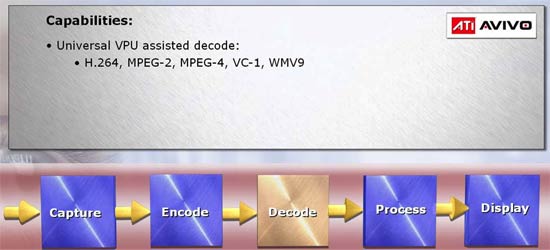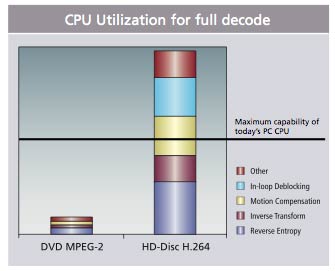ATI's Avivo Platform - H.264 Decode and Transcode Acceleration on R5xx
by Anand Lal Shimpi on September 20, 2005 10:44 AM EST- Posted in
- GPUs
GPU Accelerated H.264 Decode
Transcode acceleration isn't the only thing that the R5xx GPUs will be doing; as we saw at Computex, ATI has had working H.264 decode acceleration for months now, and it will be a requirement for all Avivo platforms.
Keep in mind that we're still talking about GPU assisted decode, so there are still a lot of functions that are done by the CPU. Avivo GPUs will perform in-loop deblocking, motion compensation and inverse transform.
The H.264 decode acceleration of Avivo GPUs is quite important, mostly because both the next-generation DVD standards (HD-DVD and Blu-ray) will both use H.264 as the encoding format for video stored on the discs.
For what it's worth, NVIDIA has committed to delivering H.264 decode acceleration later this year on their GeForce 7 based products; but we have yet to see a live demo of the technology.
Transcode acceleration isn't the only thing that the R5xx GPUs will be doing; as we saw at Computex, ATI has had working H.264 decode acceleration for months now, and it will be a requirement for all Avivo platforms.

Keep in mind that we're still talking about GPU assisted decode, so there are still a lot of functions that are done by the CPU. Avivo GPUs will perform in-loop deblocking, motion compensation and inverse transform.


The H.264 decode acceleration of Avivo GPUs is quite important, mostly because both the next-generation DVD standards (HD-DVD and Blu-ray) will both use H.264 as the encoding format for video stored on the discs.
For what it's worth, NVIDIA has committed to delivering H.264 decode acceleration later this year on their GeForce 7 based products; but we have yet to see a live demo of the technology.










22 Comments
View All Comments
spinportal - Wednesday, August 27, 2008 - link
The missing line that connects all the dots here is a beefy home video media server that transcodes & streams to all your uPnP / mobile-wireless devices, such as the PS3, Wii, XBox360, PSP, iPhone, wifi enabled phones, wifi Archos, laptops, etc.ATI/AMD has dropped the ball. They tossed their home entertainment chip (Xileon - All-In-Wonder) group, so it doesn't appear they want in this space. They aborted the whole transcode deal after X1000. Is Hollywood (and possibly Cable co's) putting on the pressure?
Now if transcoding multiple streams by a media server with Nvidia cards make it easy to feed a whole house load of people / devices wirelessly (draft-n 2.0 with dual-band), imagine the next reaction for big media would be to squash it. They don't want people having huge collections of movies, be it in h.264, XVID, or WMV format on some multi-terabyte home server (there are some nice single purpose living-room jukebox multi-media players like TOMACRO or TVIX that can access wireless file-servers as well, or stand-alone DIVX DVD players with USB connectivity - to a external USB HDD e.g. cheap 500GB+ storage) which can pump video on demand out. It can then inch out into the SlingBox territory where you can serve out to the net; which TVersity, Orb, etc. others can do, but security and lock-down is for the more technically inclined.
The better the transcoder, the better the bit-rate per stream, and then if that target is reached, the transcoder PC can crunch out even more streams. Most media servers are so-so at the 480p level, much less acceptable quality at 720p or dare tread on 1080p content with decent frame rates; and wireless-n would strain to get even one 720p stream going on a home network. The bandwidth is just not there. But what's to stop some indie service to blast Hulu and YouTube like sites with VOD services? Is NetFlix or ComCast or TimeWarner going to be able to put such powerful transcoder cards to task so they can bring real VOD library to the masses? The state of the art today for the consumer is rather toy-like, and I bet Hollywood would rather it stay that way.
Will this bring cable TV to a true a-la-carte vision were VOD servers rule the day where time schedules will end (TV Guides will be revamped to a library style navigation) and can serve up to any wireless device in your house through the STB / (future) hub? Send a upstream request for a PSP client to get a movie, and the cable company downstreams the best specific format; or a SD-TV in the bedroom via an XBox360 for junior, or the HD-TV in the livingroom, all crunched out by the big iron video servers behind the scenes at the cable co. home base using Nvidia cards (or maybe a few 9500Ms in SLI mode and optimized for CUDA to perform local transcode on the STB?) This second scenario is more likely, where control is under Hollywood's management.
If you were able to download raw TS off a DVR to a PC, the genie would be out of the bottle. Take the raw file, crunch to an acceptable compressed codec, then transcode as needed. Why showcase all your DVD boxes on a shelf? Just have a 2 TB+ SAN with a media server and a wireless-g/n gigabit router to serve all your wireless devices (and quite affordable if you know what you're doing but poor quality). The next step is to have complete transcodes done for your device to take with you on the go and out of wired/wireless range without a middleman approach of using a PC to manage the file drop to a media card. Just pick what you want to store locally on the PVP device instead of stream for later. Imagine that done 10x faster. Imagine 10x the amount of devices you can serve in the house. Your bedroom media hub, the living room media hub, the kids XBox360/PS3/Wii, the kids PSP, your Archos for the transmit commute, your iPhone (for those bathroom breaks - you wouldn't drive and watch your iPhone would you?), a laptop or two, an eeePC in the kitchen for streaming the Food Network, etc. Devices are getting smaller, mobile, and multi-function, yet there needs to be that mainstay PC to be the workhorse video transcoder.
jccapture - Thursday, September 22, 2005 - link
Will this accept Component inputs (R G B) not just composite? The article talks about video capture.prokaryote21 - Tuesday, September 20, 2005 - link
Intel viiv... hmmm roman numerals for "6" "4" or am I playing the part of captain obvious here?anselhelm - Thursday, September 22, 2005 - link
It doesn't mean 64 (it could mean 6-4, but it seems unlikely.) The Inquirer presented that idea initially, but they told us it's "Vyve" (that's my phoenetic way of saying "VIIV" in case some person tries to say it like the French "vive") and is probably more to do with the fact that it's one generation after Pentium 4. Plus, you've got the fact that VIIV sounds like alive. It's more likely to have something to do with Visualisation than the fact that it's 64-bit enabled.Of course, I (and everyone else) could be wrong here.
nserra - Wednesday, September 21, 2005 - link
V could also mean VirtualizationI Inside
I Intel
V ...
wcpaul - Tuesday, September 20, 2005 - link
The whole software situation for capturing and watching TV on a PC today is a disaster.With my Radeon 8500DV, I can capture virtually lossless MPEG at 15Mbs and view TV without a home theater app taking over the whole screen. There is NOT ONE solution today that lists exactly what capture parameters (bitrate, GOP structure, etc.) can be set and NOT ONE which shows a lightweight viewing/capture app.
Nvidia cards have "VIVO" but there is no mention anywhere of the specs (hardware encode=??, bitrate=??, ADC= ?? bit) and no mention of software or even whether a WDM driver exists for encoding. Not one reviewer has touched it. Nice going Nvidia.
The Theater 550 cards have great hardware specs but don't come with any useable software. (The app from craig-tv.com might support it soon and that should help.)
ATI should take today's announcement and shove it where their software manager's heads are. It is useless to the very people who most need the solution.
By the way, Nvidia MUST charge for their decoder. A visible company like that would be sued bigtime for distributing a standalone MPEG encoder or decoder without paying MPLA the royalty. The deinterlacing IS revolutionary but it does not play 1080i at all for me in WMP10 and required an enormous amount of hacking to work with other apps (Moonlight-Elecard demuxer was needed).
Leper Messiah - Wednesday, September 21, 2005 - link
Having had the same exact GPU (AIW 8500DV, now modded with a 9800pro heatsink and running 320/300) I must say that while the intergration is nice, the ATi theater chip in that thing sucks in comparison to now. Picture is very grainy, and artifacts like mad on full screen...Hm. I'm suprised that they didn't include chipset as a part of the deal...
AnnoyedGrunt - Tuesday, September 20, 2005 - link
First, NV must PAY ROYALTIES for the decoder, but that does not mean they must CHARGE for it. When they advertise it as features of the card, a valid assumption would be that the price of the decoder is already included in the cost of the card. I think NV was able to pull a fast one with the PureVideo fiasco, and I hope that in the future they are more clear about what exactly you get with the video card and what exactly you must pay extra for.Second, while I haven't had an NV card since my GF3 Ti200 @home, I will say that both my 9700pro and X800XL are nowhere near as stable as my GF3 was. In CoD, my 9700pro would crash frequently in a couple specific locations and in WoW my X800XL frequenly has screen corruption, fails to Alt-tab to the desktop (leaves the game, but doesn't make it back to the desktop and just sits there with a blank screen), and I get VPU recovery problems in WoW as well. Furthermore, in CAD work (specifically Pro/Engineer, which is not a very stable program itself) the ATI cards have many OpenGL driver problems. So, while the ATI drivers may be close in quality to NV's (and quite possibly better in some ways), in my experience they don't quite match up. However, in general the ATI offerings are "good enough" for home use.
Third, I really think that the video industry has a long way to go before any of these features become mainstream. I would really like to be able to plug an HD antenna into my computer somehow, and get local HD broadcasts that I could then record, but it seems like there is no real "product" for doing that. Maybe this ATI effort will give enough people hardware that the software will follow.
-D'oh!
KeithP - Tuesday, September 20, 2005 - link
I am not real familar with the different codecs involved but why don't they allow you to capture and encode in H.264 instead of doing MPEG-2 capture and forcing a conversion? Is that just too CPU intensive?TheInvincibleMustard - Tuesday, September 20, 2005 - link
I'm curious if there's anything mentioned in the platform about DRM-enabled content protection over digital outputs, as is going to be required with Vista for next-gen hi-def movies.